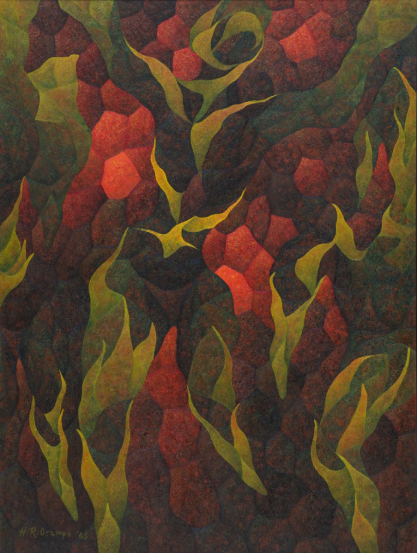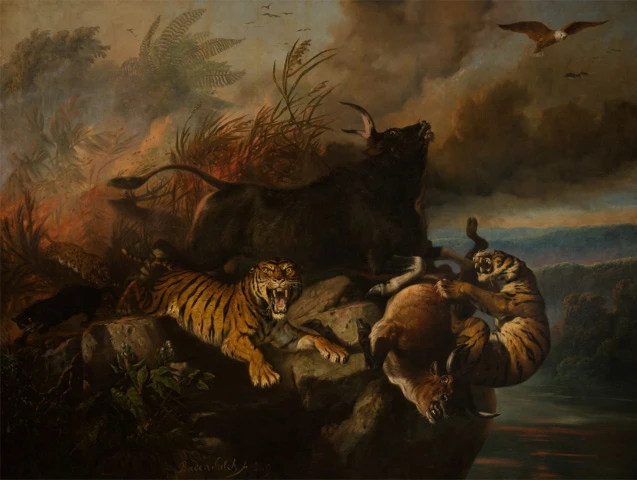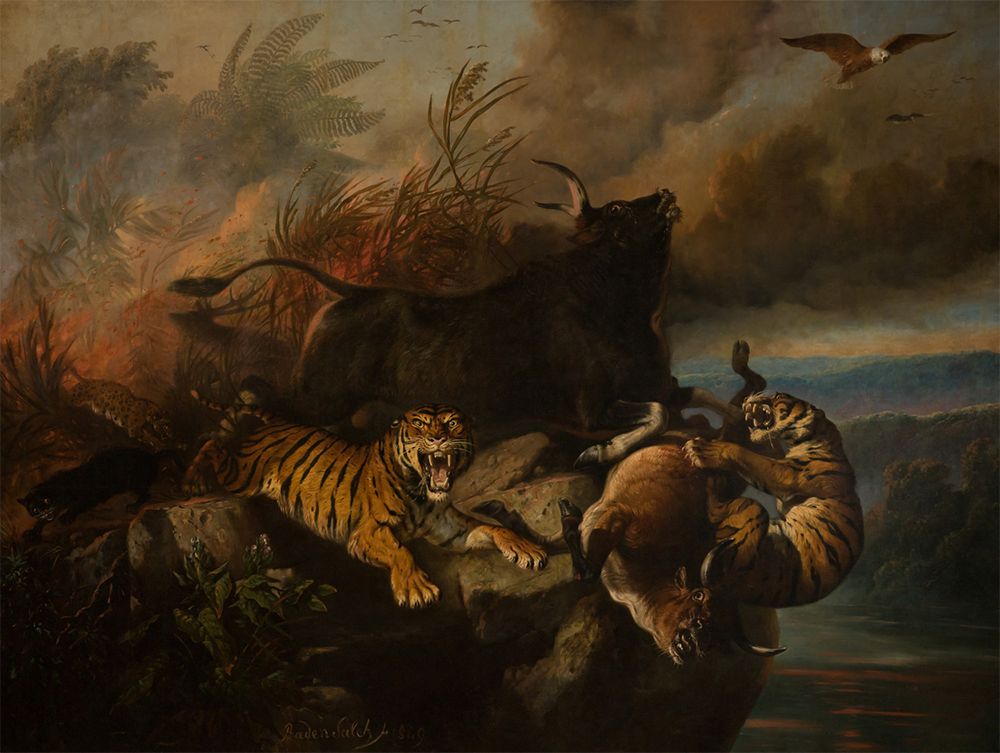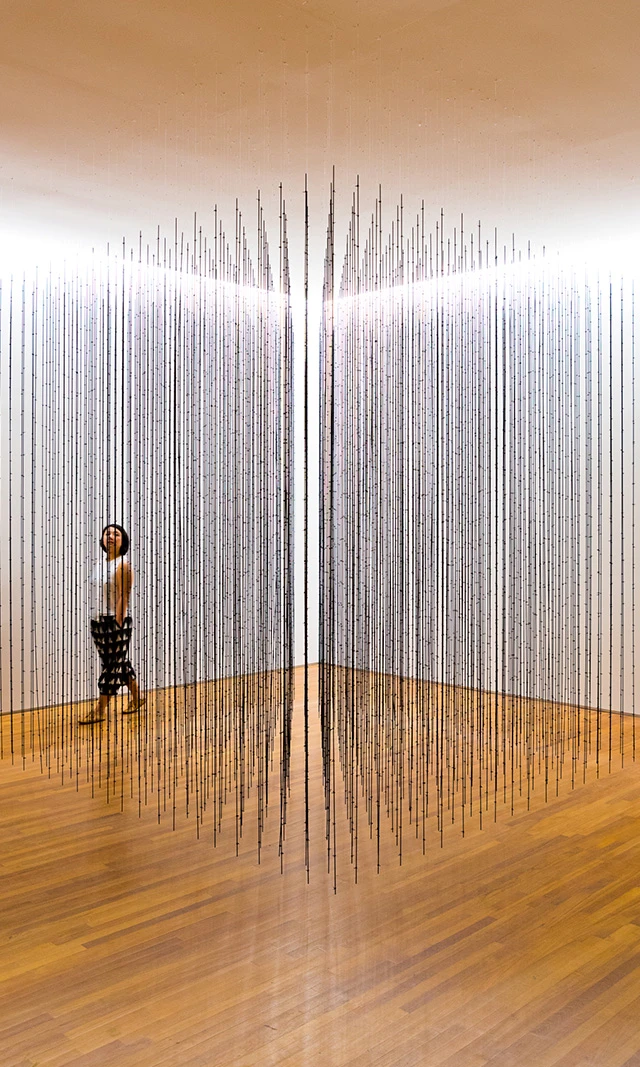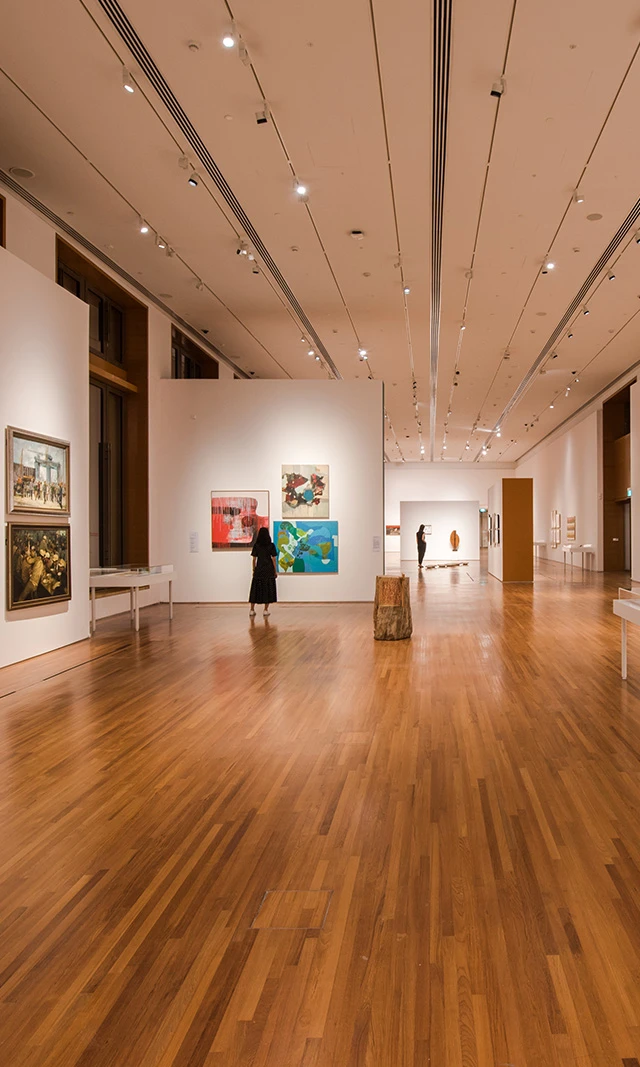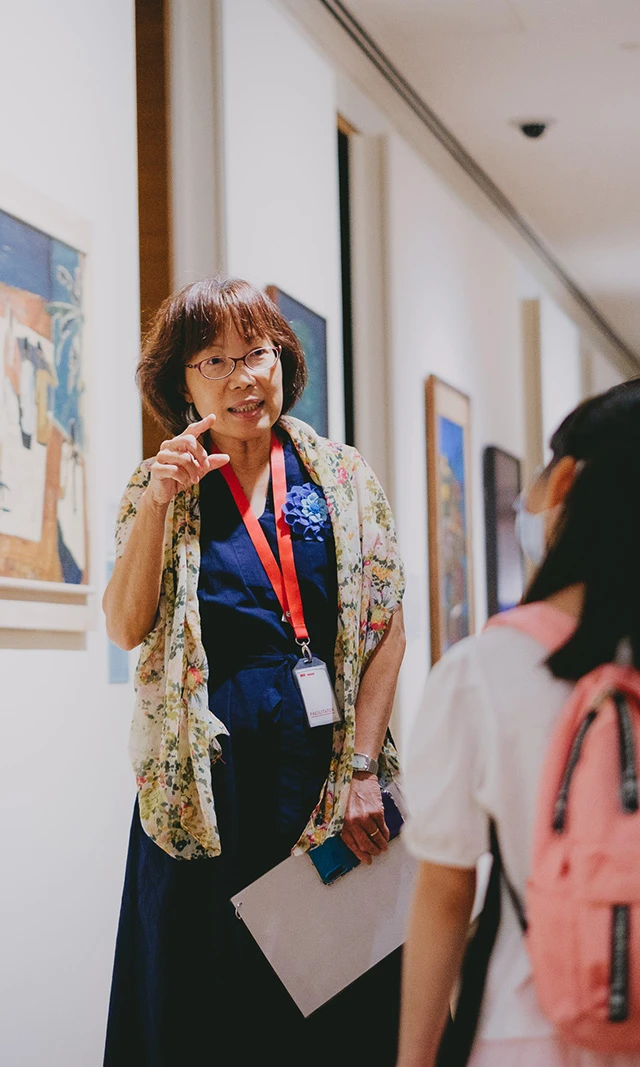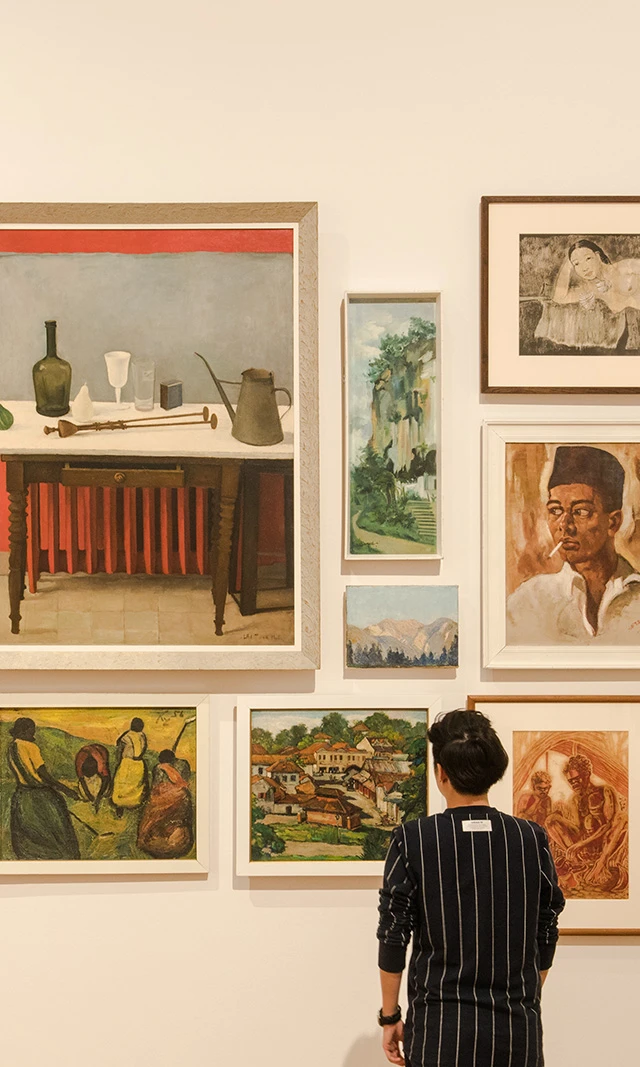The Mystical Reality Reinvented: Hua
Welcome to the Slow Art Guide for The Mystical Reality Reinvented: Hua by Sulaiman Esa brought to you by National Gallery Singapore.
Inspired by the principles of slow looking and mindfulness, each episode of the Slow Art Guide will take you on a deep dive into one artwork in the Gallery. This experience is about slowing down, taking your time to look at and contemplate visual art and savouring it in a conscious and deliberate manner.
As you immerse yourself in this sensory and reflective process, we invite you to be present with your thoughts, emotions and body sensations, which may feel quite intense or overwhelming at times. If this is the case for you today, please feel free to step away from this audio experience and head over to the Calm Room or any other space that feels safe to rest.
By the end of your experience with the Slow Art Guide, we hope that you will have a deeper emotional connection with the artwork and feel more grounded and rested in the present moment.
Take a moment to be with yourself. Express gratitude to yourself for taking time out of your busy day to care for your mind, body and spirit by connecting with visual art.
Let’s begin with a simple breathing exercise. Focus on the sensation of your breathing. There is no need to change or modify anything. Just breathe. You may choose to close your eyes and rest them or maintain a soft gaze. As you inhale and exhale, observe the rhythm of your breathing. Pay attention to your breath: Is it long and smooth, or short and quick?
If you wish, you can put a hand on your belly. Feel the warmth of your hand on your body and the affection it conveys. Sense the expansion and contraction of your belly with each breath. Allow your body to rest as you breathe. Allow your breath to support you.
Breathe in, breathe out. Breathe in, breathe out.
If your eyes have been closed, slowly open them.
This is The Mystical Reality Reinvented: Hua by Sulaiman Esa.
As we explore this artwork together, feel free to move around it in a way that is most comfortable for you. You may even sit on the gallery floor in front of the artwork.
We will give you some time to take in the artwork on your own. Think about what you are seeing in front of you and how it makes you feel.
What catches your eye immediately and how does the work make you feel? What are you most curious about?
Now, let’s take a look at the artwork together. Observe the cage closely. Is this structure familiar to you? Where have you seen such a cage before and what was it used for?
The cage is made of rattan, a type of organic material, which is painted silver. Why do you think it was created with these materials?
How do you think the contrast between the natural and artificial elements contributes to the meaning of the artwork? Could the artist have painted the rattan silver in order to conceal or to protect something?
Now look at the single rose stalk enclosed within the cage. What do you think the rose represents? Why did the artist choose a rose? Would you perceive the artwork differently if a different flower was placed in the cage?
Imagine if it were a sunflower or a daisy instead. Each flower carries a unique meaning. Consider how a sunflower or daisy may reshape how you understand the artwork.
Now, imagine the rose was placed in a different position. What if it was propped up vertically against the side of the cage? What if it floated in the middle of the cage, suspended from the top with a string? What might each of these positions symbolise?
Let’s reflect on the relationship between the rose and the cage. Do you see the cage as a confining structure, which restricts the growth and freedom of the rose? Or do you think it is a sanctuary, which offers protection and safety to the rose?
Now, imagine yourself as a part of this artwork. Do you identify more with the rose within the cage or with the cage itself? Perhaps you feel that you are a blend of both? For many of us, it is likely that how we feel about the different elements of the artwork will shift depending on our current circumstances.
There may be times in our lives where we find ourselves feeling restricted and confined, much like the rose in the cage. There may also be times where something that once felt comfortable and safe now feels stagnant or restrictive. We may feel like venturing outside our comfort zone, or seeking out new experiences and growth.
At other times, we may feel that we are holding ourselves or others back, because we are afraid, or anxious, or wanting to offer protection—much like the cage itself in this artwork.
Regardless of the situation, practising mindfulness can be a meaningful way of processing what is happening. Mindfulness can help us notice what is going on in our minds, hearts and bodies, and to give us pause. It can help us gain clarity, examine our options and find a way forward.
Give it a try. Be still and close your eyes gently if you wish to, or maintain a soft gaze. Bring your attention to your breathing. Connect with the present moment.
Notice where you feel the breath in your body, and how your body moves with each inhale and exhale. As you breathe in, sense the contact points between your body and the floor beneath you, supporting you. As you breathe out, release any tension and allow your body to be at ease. Acknowledge and allow whatever thoughts, emotions and bodily sensations you may have in this moment. Let them be.
With each new breath, send love and gratitude to yourself. If you are comfortable, gently wrap your arms around yourself in a comforting embrace, or place your hands on your chest, belly or shoulders. Savour the warmth and kindness you are offering to yourself.
Allow your chest to gently rise and fall as you breathe. Slowly extend your arms outward. Notice how this posture encourages your spine to lengthen, drawing you upwards towards the ceiling. If at any point these movements don't feel comfortable, feel free to continue with smaller gestures. With this practice, the goal is to engage in movements that bring you comfort and feel right for you.
Now bring your arms back to your sides and feel the stability of your posture.
With your next inhale, imagine opening yourself up to the different possibilities present in your life, whether it is a new opportunity or transformation that you have been contemplating. Notice the sensations that arise within your body when you hold these possibilities in mind. Extend feelings of love and gratitude to yourself for the courage it takes to explore these potential paths.
Allow each breath you take to amplify your connection to the diverse possibilities in your life.
Breathe in, breathe out. Breathe in, breathe out.
As we come towards the end of this meditation exercise, you may wish to reflect on this question: What is one small step you could take to step out of your comfort zone? Perhaps wear a colour you don't usually wear? Explore a new cuisine? Start small and see how that feels. How might this action resonate with your sense of growth and well-being?
If your eyes have been closed, slowly open them and re-familiarise yourself with your surroundings. Take a moment to feel the connection between your breath and the present moment.
Now, focus your gaze on the artwork before you.
This artwork was commissioned by the Gallery in 2015 to complement the archival display of the historic 1974 exhibition, Towards a Mystical Reality: A Documentation of Jointly Initiated Experiences, by Redza Piyadasa and Sulaiman Esa.
This original exhibition challenged viewers’ associations with paintings and picture-making in the Western art tradition by presenting an assortment of everyday objects. A pivotal showcase of conceptual art, it marked a paradigm shift in how art was received and theorised in Malaysia. The exhibition emphasised critical inquiry, challenged traditional definitions of art and resisted dominant Western art discourse.
This artwork, The Mystical Reality Reinvented: Hua, serves as Sulaiman’s reinterpretation of the 1974 exhibition from today's perspective, reflecting the evolution of his practice over the years.
We have now come to the end of this episode of the Slow Art Guide.
If you enjoyed this episode, you can check out our other episodes, which feature different artworks. Each Slow Art Guide is developed with unique slow looking and mindfulness practices to help you look at an artwork meaningfully. Artworks featured in the Slow Art Guide are from The Care Collection, a selection of artworks from the National Collection that are thematically organised for programmes that support well-being.
If you need a dedicated space for sensory and emotional rest, you can visit the Calm Room, which is located in Basement 1 of the Gallery’s City Hall Wing. In the Calm Room, you can experience a ten-minute focused mindfulness exercise.
We now invite you to continue your journey through the Gallery. Take your time to appreciate the art all around you.
Artwork details
Dimensions 3D: Object Dimensions: 90 x 57 x 57 cm

